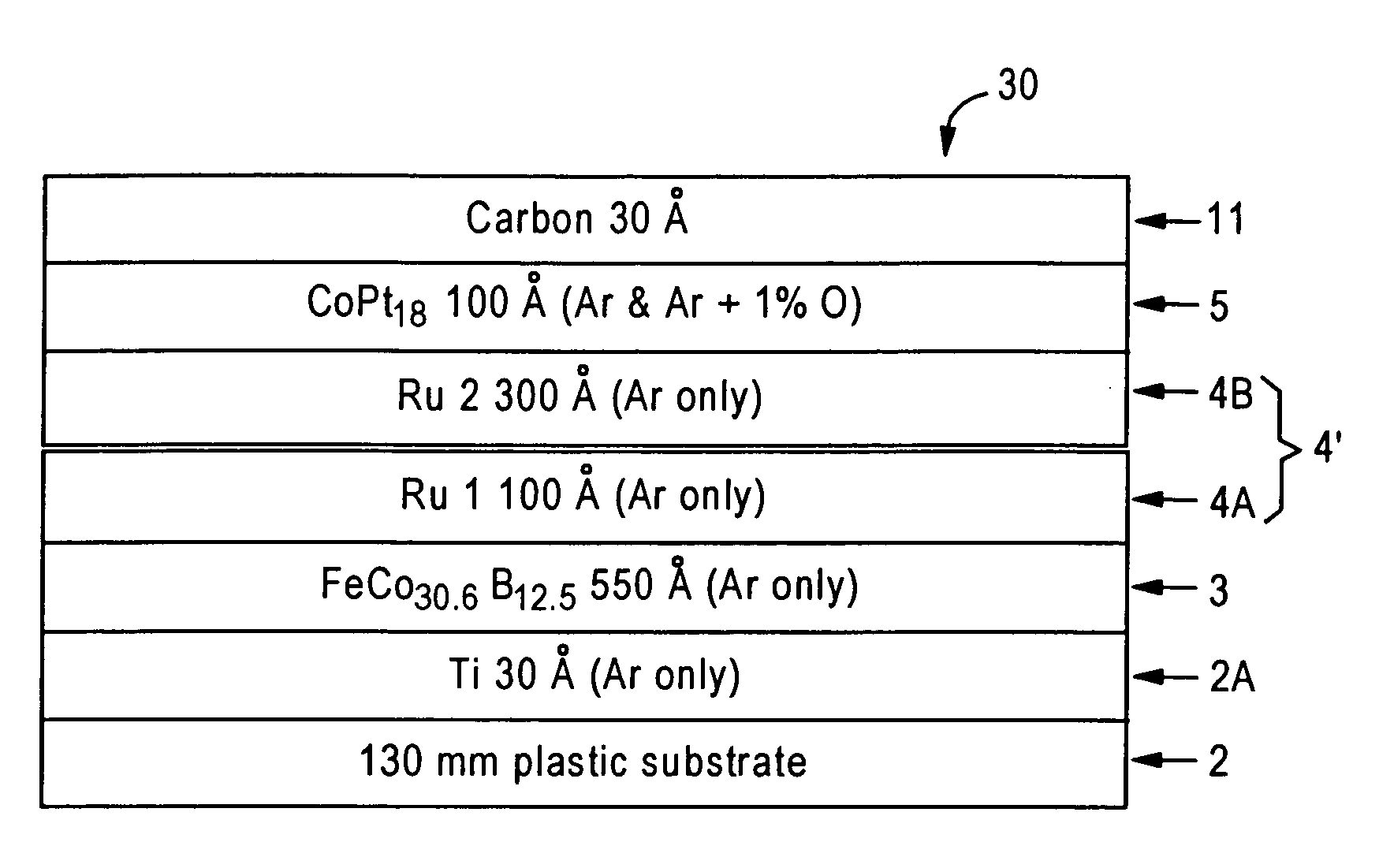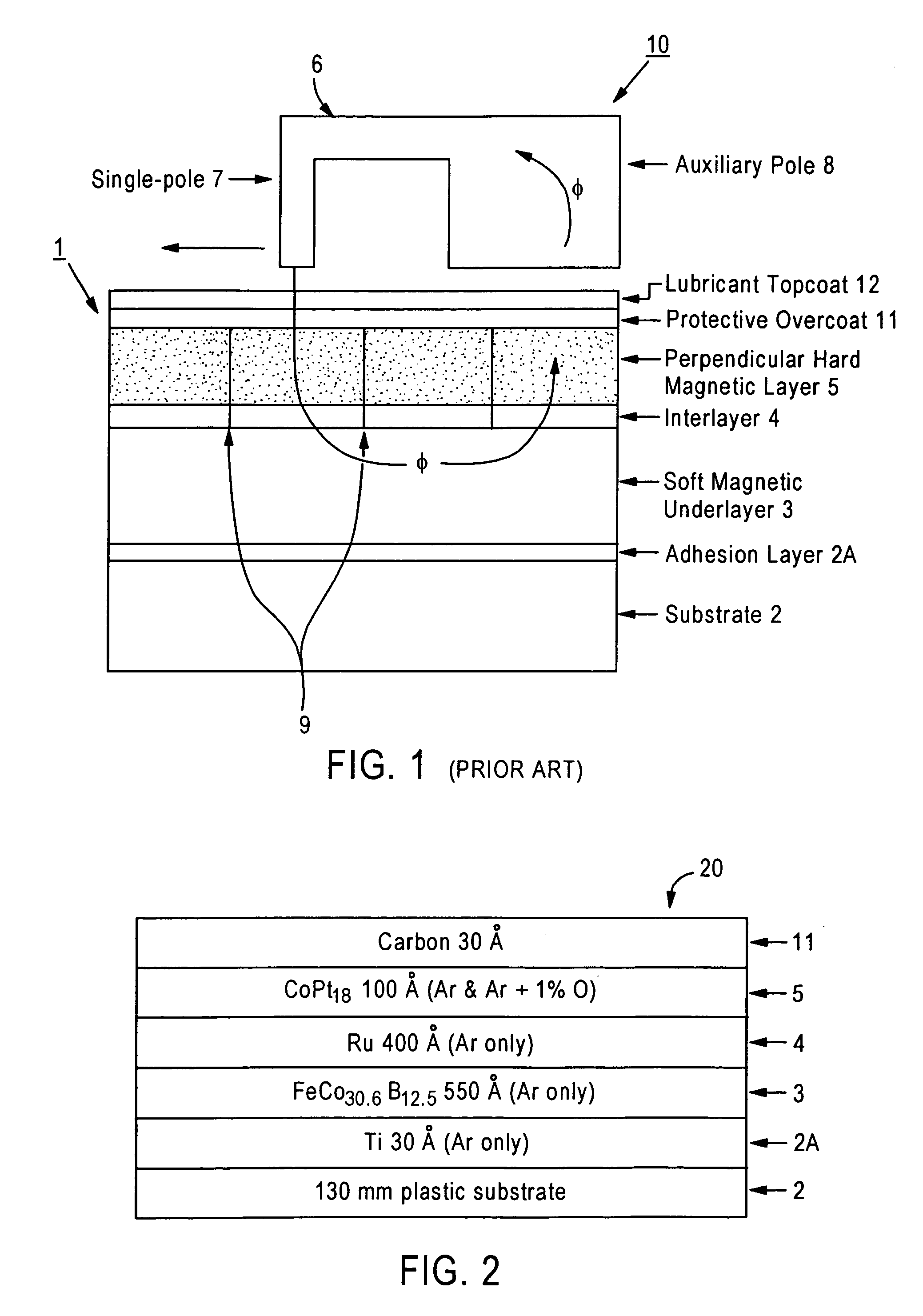High coercivity perpendicular magnetic recording media on polymer substrates
a magnetic recording medium and high coercivity technology, applied in the field of high coercivity perpendicular magnetic recording media, can solve the problems of unsuitability for lower cost disk drive applications, limited use of high temperature resistant polymer materials, etc., and achieve the effects of improving perpendicular magnetic recording medium, and low cost polymer substra
- Summary
- Abstract
- Description
- Claims
- Application Information
AI Technical Summary
Benefits of technology
Problems solved by technology
Method used
Image
Examples
example 1
[0125]Granular perpendicular magnetic recording media comprising polycarbonate and glass substrates (for comparison) of the following structure were fabricated by means of sputter deposition techniques, wherein the substrate was at or near room temperature during each sputter deposition step:
[0126]130 mm polycarbonate or glass substrate / / 30 Å Ti seed / adhesion layer, sputtered in Ar only / / 550 Å FeCo30.6B12.5 soft magnetic underlayer, sputtered in Ar only / / 400 Å Ru non-magnetic interlayer, sputtered in Ar only / / 100 Å CoPt18 granular perpendicular hard magnetic recording layer, sputtered in Ar+1% O2 / / 30 Å C protective overcoat layer, sputtered in 50 vol. % Ar / 50 vol. % H2.
[0127]Kerr M-H hysteresis loop data comparing the magnetic performance characteristics of the above-configured granular perpendicular recording media are given in Table I below:
[0128]
TABLE ISubstrateHc (Oe)Hn (Oe)SS*Glass647130900.9840.486Polycarbonate526636050.9800.691
[0129]The magnetic performance data of Table I de...
example 2
[0130]A series of granular perpendicular magnetic recording media of layer structure similar to that of the media of Example 1 was fabricated, wherein, as in the previous Example, each of the constituent layers, except for the granular perpendicular hard magnetic recording layer, was sputter-deposited in an Ar atmosphere only, with the substrate temperature being at or near room temperature during each sputter deposition step, and the non-magnetic interlayer consisted of a 400 Å thick single Ru layer or a first, or lower, 100 Å thick Ru layer (“Ru 1” in the following Table II) and a thicker second, or upper, 300 Å thick Ru layer (“Ru 2” in Table II) sputter-deposited in a higher pressure Ar atmosphere than that utilized for Ru 1. Kerr M-H hysteresis loop data comparing the magnetic performance characteristics of the above-configured granular perpendicular recording media are summarized in Table II below:
[0131]
TABLE IIDiskAr PressureCoPt18I.D. #SubstrateRu 1Ru 2Ar + 0.1% O2Hc (Oe)Hn ...
PUM
| Property | Measurement | Unit |
|---|---|---|
| glass transition temperatures | aaaaa | aaaaa |
| temperature | aaaaa | aaaaa |
| thickness | aaaaa | aaaaa |
Abstract
Description
Claims
Application Information
 Login to View More
Login to View More - R&D
- Intellectual Property
- Life Sciences
- Materials
- Tech Scout
- Unparalleled Data Quality
- Higher Quality Content
- 60% Fewer Hallucinations
Browse by: Latest US Patents, China's latest patents, Technical Efficacy Thesaurus, Application Domain, Technology Topic, Popular Technical Reports.
© 2025 PatSnap. All rights reserved.Legal|Privacy policy|Modern Slavery Act Transparency Statement|Sitemap|About US| Contact US: help@patsnap.com



